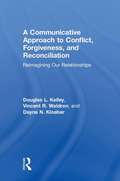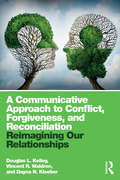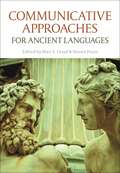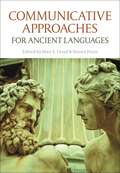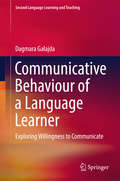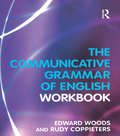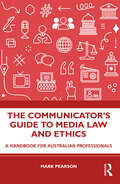- Table View
- List View
A Communicative Approach to Conflict, Forgiveness, and Reconciliation: Reimagining Our Relationships (PDF)
by Douglas L. Kelley Vincent R. Waldron Dayna N. KloeberA Communicative Approach to Conflict, Forgiveness, and Reconciliation: Reimagining Our Relationships synthesizes communication and psychology scholarship that focuses on rebuilding ourselves and our relationships when things go "wrong". It provides fresh insights into the burgeoning body of forgiveness research, with an emphasis on community application and reconciliation. Written by award winning scholars in forgiveness communication, the book makes forgiveness and reconciliation research accessible to students in courses focused on personal relationships, conflict, and family studies.
A Communicative Approach to Conflict, Forgiveness, and Reconciliation: Reimagining Our Relationships
by Douglas L. Kelley Vincent R. Waldron Dayna N. KloeberA Communicative Approach to Conflict, Forgiveness, and Reconciliation: Reimagining Our Relationships synthesizes communication and psychology scholarship that focuses on rebuilding ourselves and our relationships when things go "wrong". It provides fresh insights into the burgeoning body of forgiveness research, with an emphasis on community application and reconciliation. Written by award winning scholars in forgiveness communication, the book makes forgiveness and reconciliation research accessible to students in courses focused on personal relationships, conflict, and family studies.
A Communicative Approach to Conflict, Forgiveness, and Reconciliation: Reimagining Our Relationships
by Douglas L. Kelley Vincent R. Waldron Dayna N. KloeberA Communicative Approach to Conflict, Forgiveness, and Reconciliation: Reimagining Our Relationships synthesizes communication and psychology scholarship that focuses on rebuilding ourselves and our relationships when things go "wrong". It provides fresh insights into the burgeoning body of forgiveness research, with an emphasis on community application and reconciliation. Written by award winning scholars in forgiveness communication, the book makes forgiveness and reconciliation research accessible to students in courses focused on personal relationships, conflict, and family studies.
Communicative Approaches for Ancient Languages
by Mair E. Lloyd and Steven HuntThis book is the first in its field. It showcases current and emerging communicative practices in the teaching and learning of ancient languages (Latin and Greek) across contemporary education in the US, the UK, South America and continental Europe. In all these parts of the globe, communicative approaches are increasingly being accepted as showing benefits for learners in school, university and college classrooms, as well as at specialist conferences which allow for total immersion in an ancient language. These approaches are characterised by interaction with others using the ancient language. They may include various means and modalities such as face-to-face conversations and written communication. The ultimate aim is to optimise the facility to read such languages with comprehension and engagement.The examples showcased in this volume provide readers with a vital survey of the most current issues in communicative language teaching, helping them to explore and consider adoption of a wider range of pedagogical practices, and encouraging them to develop tools to promote engagement and retention of a wider variety of students than currently find ancient languages accessible. Both new and experienced teachers and learners can build on the experiences and ideas in this volume to explore the value of these approaches in their own classrooms.
Communicative Approaches for Ancient Languages
This book is the first in its field. It showcases current and emerging communicative practices in the teaching and learning of ancient languages (Latin and Greek) across contemporary education in the US, the UK, South America and continental Europe. In all these parts of the globe, communicative approaches are increasingly being accepted as showing benefits for learners in school, university and college classrooms, as well as at specialist conferences which allow for total immersion in an ancient language. These approaches are characterised by interaction with others using the ancient language. They may include various means and modalities such as face-to-face conversations and written communication. The ultimate aim is to optimise the facility to read such languages with comprehension and engagement.The examples showcased in this volume provide readers with a vital survey of the most current issues in communicative language teaching, helping them to explore and consider adoption of a wider range of pedagogical practices, and encouraging them to develop tools to promote engagement and retention of a wider variety of students than currently find ancient languages accessible. Both new and experienced teachers and learners can build on the experiences and ideas in this volume to explore the value of these approaches in their own classrooms.
Communicative Behaviour of a Language Learner: Exploring Willingness to Communicate (Second Language Learning and Teaching)
by Dagmara GałajdaThis book investigates and analyzes the way in which factors such as communication apprehension, self-perceived communicative competence and group dynamics influence the communicative behavior of a foreign-language learner. It also focuses on interpersonal communication, group communication and public speaking. Using selected models it characterizes and analyzes all types of communication with reference to communication in the language classroom, with a particular emphasis on the foreign-language context. The author also presents some conclusions and implications for both language teachers and language learners, as well as offering suggestions for further research in the field of classroom communication. The results of the study serve as a point of reference for teachers interested in the construct of willingness to communicate and other communication variables related to the issue of communication in a foreign language. The work also raises teachers' awareness of individual learner differences in the context of communication in the foreign-language classroom.
Communicative Biocapitalism: The Voice of the Patient in Digital Health and the Health Humanities
by Olivia BannerThe Precision Medicine Initiative, Apple’s HealthKit, the FitBit—the booming digital health industry asserts that digital networks, tools, and the scientific endeavors they support will usher in a new era of medicine centered around “the voice of the patient.” But whose “voices” do such tools actually solicit? And through what perspective will those voices be heard? Digital health tools are marketed as neutral devices made to help users take responsibility for their health. Yet digital technologies are not neutral; they are developed from an existing set of assumptions about their potential users and contexts for use, and they reflect dominant ideologies of health, dis/ability, gender, and race. Using patient-networking websites, the Quantified Self, and online breast cancer narratives, Communicative Biocapitalism examines the cultural, technological, economic, and rhetorical logics that shape the “voice of the patient” in digital health to identify how cultural understandings and social locations of race, gender, and disability shape whose voices are elicited and how they are interpreted.
Communicative Competence, Classroom Interaction, and Educational Equity: The Selected Works of Courtney B. Cazden
by Courtney B. CazdenIn the World Library of Educationalists series, international scholars themselves compile career-long collections of what they judge to be their finest pieces—extracts from books, key articles, salient research findings, major theoretical and/or practical contributions—so the world can read them in a single manageable volume. Readers thus are able to follow the themes and strands of their work and see their contribution to the development of a field, as well as the development of the field itself. Contributors to the series include: Michael Apple, James A. Banks, Joel Spring, William F. Pinar, Stephen J. Ball, Elliot Eisner, Howard Gardner, John Gilbert, Ivor F. Goodson, and Peter Jarvis. In this volume, Courtney B. Cazden, renowned educational sociolinguist, brings together a selection of her seminal work, organized around three themes: development of individual communicative competence in both oral and written language and discourse; classroom interaction in learning and teaching; and social justice/educational equity issues in wider contexts beyond the classroom. Since the 1970s, Cazden has been a key figure in the ethnography of schooling, focusing on children’s linguistic development (both oral and written) and the functions of language in formal education, primarily but not exclusively in the United States. Combining her experiences as a former primary schoolteacher with the insight and methodological rigor of a trained ethnographer and linguist, Cazden helped to establish ethnography and discourse analysis as central methodologies for analyzing classroom interaction. This capstone volume highlights her major contributions to the field.
Communicative Competence, Classroom Interaction, and Educational Equity: The Selected Works of Courtney B. Cazden
by Courtney B. CazdenIn the World Library of Educationalists series, international scholars themselves compile career-long collections of what they judge to be their finest pieces—extracts from books, key articles, salient research findings, major theoretical and/or practical contributions—so the world can read them in a single manageable volume. Readers thus are able to follow the themes and strands of their work and see their contribution to the development of a field, as well as the development of the field itself. Contributors to the series include: Michael Apple, James A. Banks, Joel Spring, William F. Pinar, Stephen J. Ball, Elliot Eisner, Howard Gardner, John Gilbert, Ivor F. Goodson, and Peter Jarvis. In this volume, Courtney B. Cazden, renowned educational sociolinguist, brings together a selection of her seminal work, organized around three themes: development of individual communicative competence in both oral and written language and discourse; classroom interaction in learning and teaching; and social justice/educational equity issues in wider contexts beyond the classroom. Since the 1970s, Cazden has been a key figure in the ethnography of schooling, focusing on children’s linguistic development (both oral and written) and the functions of language in formal education, primarily but not exclusively in the United States. Combining her experiences as a former primary schoolteacher with the insight and methodological rigor of a trained ethnographer and linguist, Cazden helped to establish ethnography and discourse analysis as central methodologies for analyzing classroom interaction. This capstone volume highlights her major contributions to the field.
Communicative Competence in a Second Language: Theory, Method, and Applications (Second Language Acquisition Research Series)
by Matthew Kanwit Megan SolonCommunicative competence is an essential language skill, the ability to adjust language use according to specific contexts and to employ knowledge and strategies for successful communication. This unique text offers a multidisciplinary, critical, state-of-the-art research overview for this skill in second language learners. Expert contributors from around the world lay out the history of the field, then explore a variety of theoretical perspectives, methodologies, and empirical findings, and authoritatively set the agenda for future work. With a variety of helpful features like discussion questions, recommended further reading, and suggestions for practice, this book will be an invaluable resource to students and researchers of applied linguistics, education, psychology, and beyond.
Communicative Competence in a Second Language: Theory, Method, and Applications (Second Language Acquisition Research Series)
by Matthew Kanwit Megan SolonCommunicative competence is an essential language skill, the ability to adjust language use according to specific contexts and to employ knowledge and strategies for successful communication. This unique text offers a multidisciplinary, critical, state-of-the-art research overview for this skill in second language learners. Expert contributors from around the world lay out the history of the field, then explore a variety of theoretical perspectives, methodologies, and empirical findings, and authoritatively set the agenda for future work. With a variety of helpful features like discussion questions, recommended further reading, and suggestions for practice, this book will be an invaluable resource to students and researchers of applied linguistics, education, psychology, and beyond.
The Communicative Competence of Young Children: A Modular Approach
by Susan H. Foster-CohenHow children first acquire language is one of the central issues in linguistics. This book draws on a wide range of research, including work in developmental psychology, anthropology and sociology, to explore the processes behind child language acquisition to the preschool period.
The Communicative Competence of Young Children: A Modular Approach
by Susan H. Foster-CohenHow children first acquire language is one of the central issues in linguistics. This book draws on a wide range of research, including work in developmental psychology, anthropology and sociology, to explore the processes behind child language acquisition to the preschool period.
A Communicative Grammar of English
by Geoffrey Leech Jan SvartvikA Communicative Grammar of English has long been established as a grammar innovative in approach, reliable in coverage, and clear in its explanations. This fully revised and redesigned third edition provides up-to-date and accessible help to teachers, advanced learners and undergraduate students of English. Part One looks at the way English grammar varies in different types of English, such as ‘formal’ and ‘informal’, ‘spoken’ and ‘written’; Part Two focuses on the uses of grammar rather than on grammatical structure and Part Three provides a handy alphabetically arranged guide to English grammar. A new workbook, The Communicative Grammar of English Workbook also accompanies this edition.
A Communicative Grammar of English
by Geoffrey Leech Jan SvartvikA Communicative Grammar of English has long been established as a grammar innovative in approach, reliable in coverage, and clear in its explanations. This fully revised and redesigned third edition provides up-to-date and accessible help to teachers, advanced learners and undergraduate students of English. Part One looks at the way English grammar varies in different types of English, such as ‘formal’ and ‘informal’, ‘spoken’ and ‘written’; Part Two focuses on the uses of grammar rather than on grammatical structure and Part Three provides a handy alphabetically arranged guide to English grammar. A new workbook, The Communicative Grammar of English Workbook also accompanies this edition.
The Communicative Grammar of English Workbook
by Edward Dr. Woods Rudy CoppietersThe companion text to A Communicative Grammar of English (CGE), this workbook presents an opportunity for practising the points raised in the main grammar. The units follow the order of sections in Part One and Part Two of CGE; at the beginning of each sub-unit there is a brief explanation of a particular structure followed by a series of tasks, ranging from gap filling exercises to rewrite assignments and conversational passages in which the student is invited to participate.? With authentic material and a variety of different task types graded by difficulty, this is an indispensable resource for teachers and advanced students with a good grounding in the grammar of the language.
The Communicative Grammar of English Workbook
by Edward Dr. Woods Rudy CoppietersThe companion text to A Communicative Grammar of English (CGE), this workbook presents an opportunity for practising the points raised in the main grammar. The units follow the order of sections in Part One and Part Two of CGE; at the beginning of each sub-unit there is a brief explanation of a particular structure followed by a series of tasks, ranging from gap filling exercises to rewrite assignments and conversational passages in which the student is invited to participate.? With authentic material and a variety of different task types graded by difficulty, this is an indispensable resource for teachers and advanced students with a good grounding in the grammar of the language.
Communicative Perspectives on COVID-19 in Ghana: At the Intersection of Culture, Science, Religion and Politics (Routledge Studies in Language and Intercultural Communication)
by Nancy Henaku G. Edzordzi Agbozo Mark NarteyThis collection explores the communicative dimensions of the COVID-19 pandemic in Ghana, redressing the absence of perspectives from Africa and the Global South in pandemic discourses and highlighting the importance of considering the impact of local contexts in global crises. The volume critically reflects on the significance of communicative dimensions, understood here as the effects of communication on bidirectional flows between senders and receivers, on many different aspects of the coronavirus pandemic. Grounded in transnational and interdisciplinary perspectives and drawing on data from the Ghanian experience, the book showcases how important it is for local factors to be taken into account by governments, medical professionals, social commentators, and everyday people in communicating during a pandemic, when local cultures, histories, and infrastructures all play a role in shaping communication and the dissemination of knowledge. Chapter examines such topics as the role of metaphor, the use of social media in disinformation, and the range of strategies and channels employed by stakeholders. This volume centers the pandemic experience in a Global South context, demonstrating the importance of a greater focus on local contexts in understanding communication in a time of pandemic. This book will be of interest to students and scholars in intercultural communication, crisis communication, health communication, discourse analysis, and African studies.
Communicative Perspectives on COVID-19 in Ghana: At the Intersection of Culture, Science, Religion and Politics (Routledge Studies in Language and Intercultural Communication)
by Nancy Henaku G. Edzordzi Agbozo Mark NarteyThis collection explores the communicative dimensions of the COVID-19 pandemic in Ghana, redressing the absence of perspectives from Africa and the Global South in pandemic discourses and highlighting the importance of considering the impact of local contexts in global crises. The volume critically reflects on the significance of communicative dimensions, understood here as the effects of communication on bidirectional flows between senders and receivers, on many different aspects of the coronavirus pandemic. Grounded in transnational and interdisciplinary perspectives and drawing on data from the Ghanian experience, the book showcases how important it is for local factors to be taken into account by governments, medical professionals, social commentators, and everyday people in communicating during a pandemic, when local cultures, histories, and infrastructures all play a role in shaping communication and the dissemination of knowledge. Chapter examines such topics as the role of metaphor, the use of social media in disinformation, and the range of strategies and channels employed by stakeholders. This volume centers the pandemic experience in a Global South context, demonstrating the importance of a greater focus on local contexts in understanding communication in a time of pandemic. This book will be of interest to students and scholars in intercultural communication, crisis communication, health communication, discourse analysis, and African studies.
Communicative Spaces in Bilingual Contexts: Discourses, Synergies and Counterflows in Spanish and English (Routledge Research in Language and Communication)
by Ana Sánchez-Muñoz Jessica RetisThis collection bridges disciplinary scholarship from critical language studies, Latinx critical communication, and media studies scholarship for a comprehensive exploration of Spanish-English bilingualism in the US and in turn, elucidating, more broadly, our understanding of bilingualism in a post-digital society. Chapters offer a state-of-the-art on research at the intersection of language, communication, and media, with a focus on key debates in Spanish-English bilingualism research. The volume provides a truly interdisciplinary perspective, synthesizing a wide range of approaches to promote greater dialogue between these fields and examining different communicative bilingual spaces. These include ideological spaces, political spaces, publicity and advertising spaces, digital and social media spaces, entertainment and TV spaces, and school and family spaces. This book will be of interest to students and scholars in bilingualism, language and communication, language and media, and Latin American and Chicano/a studies.
Communicative Spaces in Bilingual Contexts: Discourses, Synergies and Counterflows in Spanish and English (Routledge Research in Language and Communication)
by Ana Sánchez-Muñoz Jéssica RetisThis collection bridges disciplinary scholarship from critical language studies, Latinx critical communication, and media studies scholarship for a comprehensive exploration of Spanish-English bilingualism in the US and in turn, elucidating, more broadly, our understanding of bilingualism in a post-digital society. Chapters offer a state-of-the-art on research at the intersection of language, communication, and media, with a focus on key debates in Spanish-English bilingualism research. The volume provides a truly interdisciplinary perspective, synthesizing a wide range of approaches to promote greater dialogue between these fields and examining different communicative bilingual spaces. These include ideological spaces, political spaces, publicity and advertising spaces, digital and social media spaces, entertainment and TV spaces, and school and family spaces. This book will be of interest to students and scholars in bilingualism, language and communication, language and media, and Latin American and Chicano/a studies.
The Communicative Syllabus: A Systemic-Functional Approach to Language Teaching (Linguistics: Bloomsbury Academic Collections)
by Robin MelroseBeginning with a thorough survey of approaches to communicative syllabus design, Melrose deals with the early 1970s functional approach and subsequent criticism of it as well as the contemporary search for a process approach to language learning. It proposes a meaning negation model, which draws upon the seminal work of Halliday, Martin, Fawcett and Lemke, and is illustrated through their analysis of a unit from a communicative course book. Its topical-interactional approach is placed within the context of the current debate on language teaching and learning.
The Communicator's Guide to Media Law and Ethics: A Handbook for Australian Professionals
by Mark PearsonThis book offers an introduction to the key legal and ethical topics confronting Australian journalists and strategic communicators both at home and internationally and offers a suite of reflective techniques for navigating them. It starts by positioning morals, ethics, and the law in their historical and philosophical frameworks by tracing the evolution of free expression and professional media ethics. Media law and ethics are then contextualized in their modern international human rights framework. Readers are equipped with a skill set for reflecting on the law and ethics of professional media dilemmas – including mindful reflection, the Potter Box, journaling, concept mapping, and discussion. Such approaches are then applied to key topic areas, including free expression; reputation; confidentiality; privacy; justice; intellectual property; national security; discrimination and harassment; and conflicted interests. Each is examined in terms of its philosophical underpinnings, relationship to human rights, professional ethical context, international examples, legal principles, key Australian laws, legal cases, and strategies for applying reflective practice techniques. It concludes on a confident note – imploring communicators to engage in constructive and mindful strategic communication with the authority and confidence that results from a working knowledge of media law and ethics. This handbook is for professional communicators and students in all fields, but particularly in journalism, public relations, corporate communication, media relations, and marketing.
The Communicator's Guide to Media Law and Ethics: A Handbook for Australian Professionals
by Mark PearsonThis book offers an introduction to the key legal and ethical topics confronting Australian journalists and strategic communicators both at home and internationally and offers a suite of reflective techniques for navigating them. It starts by positioning morals, ethics, and the law in their historical and philosophical frameworks by tracing the evolution of free expression and professional media ethics. Media law and ethics are then contextualized in their modern international human rights framework. Readers are equipped with a skill set for reflecting on the law and ethics of professional media dilemmas – including mindful reflection, the Potter Box, journaling, concept mapping, and discussion. Such approaches are then applied to key topic areas, including free expression; reputation; confidentiality; privacy; justice; intellectual property; national security; discrimination and harassment; and conflicted interests. Each is examined in terms of its philosophical underpinnings, relationship to human rights, professional ethical context, international examples, legal principles, key Australian laws, legal cases, and strategies for applying reflective practice techniques. It concludes on a confident note – imploring communicators to engage in constructive and mindful strategic communication with the authority and confidence that results from a working knowledge of media law and ethics. This handbook is for professional communicators and students in all fields, but particularly in journalism, public relations, corporate communication, media relations, and marketing.
Communism and Poetry: Writing Against Capital (Modern and Contemporary Poetry and Poetics)
by Ruth Jennison Julian MurphetCommunism and Poetry: Writing Against Capital addresses the relationship between an upsurge in collective political practice around the world since 2000, and the crystallization of newly engaged forms of poetry. Considering an array of perspectives—poets, poet-critics, activists and theorists—these essays shed new light on the active interface between emancipatory political thought and poetic production and explore how poetry and the new communism are creating mutually innovative forms of thought and activity, supercharging the utopian imagination. Drawing inspiration from past connections between communism and poetry, and theorizing new directions over the years ahead, the volume models a much-needed critical solidarity with creative strategies in the present conjuncture to activate movements of resistance, on the streets and in verse.
